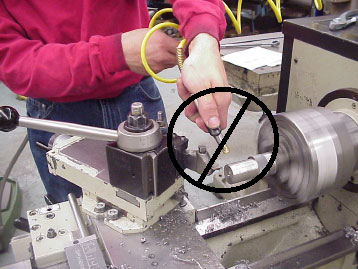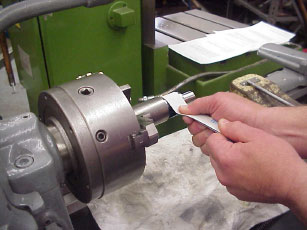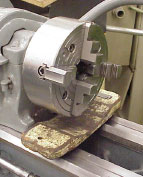| Lathe Safety |
Eye Safety-Wear safety glasses or safety goggles at all times in the shop! If a machine, such as a pedestal grinder or lathe, has a shield to deflect chips, it does not replace the need to wear safety glasses. When grinding a toolbit, if you overheat (burn) it, donít quench it as it may crack. These cracks may or may not be visible. If you can't see them and you use the toolbit, a piece of the tool may break off and fly towards your face.
House Keeping-The shop floor should be kept clear of chips, debris, and pieces of material. Any fluids, such as coolant or oil, should be cleaned up immediately.
Hand Safety- One of the most common causes of hand injuries is contact with cutting edges. The cutting edge may be moving, which is very dangerous, but even an edge that is not moving can inflict a severe cut if you move your hand over it very fast. When operating a lathe, you should not wear anything on your hands, fingers, or forearms -- this includes long sleeves and gloves. Short sleeves should be worn in the shop, or long sleeves should be rolled up above the elbows. Gloves may be worn only when handling sharp pieces of material, and not near operating machinery. They should always be removed before any machine in the area is started. Long hair should be tied back. Also, loose clothing should not be worn.
| Proper Attire-An
apron is recommended for use in the shop to help keep your clothing
clean and for safety.
An apron presents fewer openings and less loose cloth than other types of clothing. No rings, wrist watches, bracelets, or any type of jewelry or clothing that might swing or hang in an unsafe manner should be worn. |
|
| Spindle Safety
|
| Of the three common types of spindle noses, the threaded type is the most dangerous because if it is run backwards. The chuck or driver plate may unscrew off of the spindle. |
|
|
|
Also, if the spindle is turned on in reverse, or just reversed quickly, the chuck may come off and do damage to the lathe or to you. Protect the ways of the lathe with a chuck board, which will prevent nicks or burrs if something should be dropped. |
| When installing and removing chucks, face plates, and centers, always be sure all mating surfaces are clean and free from burrs. Do not use power when installing or removing chucks or faceplates on threaded spindle noses. If a chuck or faceplate should become jammed on the spindle nose, contact an instructor or the aide about removing it properly. |
|
When removing centers, be sure to handle them safely, as the point may be sharp. Use the correct knockout bar to remove the headstock center and/or sleeve. When installing or removing heavy chucks or workpieces, be sure to get help to lift them so you won't injure yourself. To help lift a chuck, place a bar of soft steel, brass, or aluminum through the chuck with enough of the bar sticking out of the back to get a good grip on it and then clamp it tight.
Now both of you can pick up the chuck and place it on the chuck board in preparation for installing it on the spindle nose. When removing it, reverse the process. Never leave a chuck key or chuck wrench in a chuck. It can be thrown out with great force and injure or kill someone. Develop the habit of never letting go of the chuck key or wrench when you are using it.
| To prevent axial (endwise) movement of a workpiece in the chuck, two
common methods are used. The first is to use a chuck
parallel, which is a three-legged piece of metal that is placed behind
the work in the chuck (Figure 5).
If a four-jaw chuck is used, use a four-legged parallel. The other way is to machine a shoulder on the workpiece that will set against the chuck jaws. Either of these methods may be used to prevent the work from pulling away from the tailstock center. |
|
| Chip Removal
|
| When cleaning the lathe, do not use compressed air (Figure 6). Compressed air will blow chips back into your face and eyes. Compressed air can also blow fine chips past the wipers on the machine. Fine chips between the mating surfaces of the machine will ruin the accuracy of the machine. |  Figure 6 Do not use compressed air when cleaning machines. |
Do not use your hands to remove chips. Use a pair of pliers for long chips and a brush for short chips. Long, unbroken chips are more dangerous than short broken chips because they tend to either pile up in a tangle of wiry chips around the cutting area or extend way out from it. When they pile up, it is hard to resist the urge to remove them. When that urge is satisfied incorrectly, you may be hurt. To satisfy it correctly, use a long pair of combination pliers to pull them away. When they extend way out, it is easy to get cut by them or have them catch on some clothing and twist and tear it. The two main types of short, broken chips (which are the safest) are the "C" shaped and figure "6" or "9" shaped chips. The figure "6" or "9" shape is considered the best type of chip when machining.
| Polishing, Filing, and Deburring
|
| For safety, as well as for convenience, all work should be deburred before being taken out of the lathe. It is easier to file burrs in the lathe as it is revolving than it is holding the part in your hand and having to try to deburr it evenly. It also saves time. When deburring by filing, use the left-hand method, which means your left hand is on the handle of the file and your right hand is on the point. |
|
You can still control the angle of the file with your predominant hand. This keeps the hands and arms away from the revolving chuck or lathe dog, which can either catch or strike you. It is OK to move the file slowly so as not to cause too much wear in one place on the file. If polishing a workpiece with abrasive cloth, do not hold both ends of the abrasive cloth together in either one hand or both.


Figure 8 Correct and incorrect polishing
methods
This can cause a pinching action. This pinching action will mash your thumbs or fingers, and pull you into the lathe. Hold one end of the cloth in one hand and the other end in the other hand. Don't let the ends get too close together as this may cause a wrapping action. This will cause the abrasive cloth, and you, to be pulled into the revolving work.
Machine Operation-Always stop the lathe to do any adjusting, measuring, cleaning, or lubricating. When it is time to stop the spindle of the lathe, there are two ways to do it. The first is to shut it off and let it coast to a stop. The other is, if the lathe is so equipped, to step on the brake treadle to stop it. Never try to stop the spindle of any machine with your hand or fingers as severe injury could result. Only one person should run a machine. If two people are trying to run it, one may do something without telling the other and an accident could happen. When working around revolving machinery, don't be careless, don't run or get involved in horseplay. When changing spindle speeds by shifting gears, the lathe must be completely stopped. If the gears are difficult to mesh, turn the spindle by hand to help align the gear teeth.
Always remember that safety is no accident.
Top ![]()





